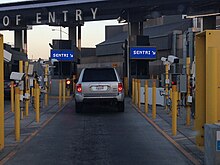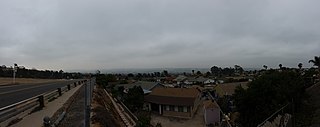
San Ysidro is a district of the City of San Diego, immediately north of the Mexico–United States border. It neighbors Otay Mesa West to the north, Otay Mesa to the east, and Nestor and the Tijuana River Valley to the west; together these communities form South San Diego, a practical exclave of the City of San Diego. Major thoroughfares include Beyer Boulevard and San Ysidro Boulevard.

The United States Border Patrol (USBP) is a federal law enforcement agency under the United States Customs and Border Protection (CBP) and is responsible for securing the borders of the United States. According to its web site in 2022, its mission is to "Protect the American people, safeguard our borders, and enhance the nation’s economic prosperity."

The Mexico–United States border wall is a series of vertical barriers along the Mexico–United States border intended to reduce illegal immigration to the United States from Mexico. The barrier is not a continuous structure but a series of obstructions variously classified as "fences" or "walls".

United States Customs and Border Protection (CBP) is the largest federal law enforcement agency of the United States Department of Homeland Security. It is the country's primary border control organization, charged with regulating and facilitating international trade, collecting import duties, as well as enforcing U.S. regulations, including trade, customs and immigration. CBP is one of the largest law enforcement agencies in the United States. It has a workforce of more than 45,600 federal agents and officers. It is headquartered in Washington, D.C.

The Mexico–United States border is an international border separating Mexico and the United States, extending from the Pacific Ocean in the west to the Gulf of Mexico in the east. The border traverses a variety of terrains, ranging from urban areas to deserts. The Mexico–U.S. border is the most frequently crossed border in the world with approximately 350 million documented crossings annually. It is the tenth-longest border between two countries in the world.
Form I-94, the Arrival-Departure Record Card, is a form used by U.S. Customs and Border Protection (CBP) intended to keep track of the arrival and departure to/from the United States of people who are not United States citizens or lawful permanent residents. While the form is usually issued by CBP at ports of entry or deferred inspection sites, USCIS can issue an equivalent as part of the Form I-797A approval notice for a Form I-129 petition for an alien worker or a Form I-539 application for extension of stay or change of status.
Otay Mesa is a community in the southern section of the city of San Diego, just north of the U.S.–Mexico border.

NEXUS is a joint Canada Border Services Agency and U.S. Customs and Border Protection-operated Trusted Traveler and expedited border control program designed for pre-approved, low-risk travelers. Members of the program can avoid waits at border entry points by using reserved lanes at land crossings into Canada and the United States, by using self-serve kiosks at airports in Canada, the US and some international locations, or by phoning border officials for a marine entry. A NEXUS membership card is a valid document under the Western Hemisphere Travel Initiative (WHTI), so it can be used in place of a passport, including by air if flying between the US and Canada. However, carrying a valid passport is still recommended, in the rare event that a flight is diverted to an airport without NEXUS support.

The McAllen–Hidalgo–Reynosa International Bridge is a road bridge completed in 1926, crossing the Rio Grande between the state of Tamaulipas in northeastern Mexico and the state of Texas in the southwestern United States.
The Juárez–Lincoln International Bridge is one of four vehicular international bridges located in the cities of Laredo, Texas, and Nuevo Laredo, Tamaulipas, that connect the United States and Mexico over the Rio Grande. It is owned and operated by City of Laredo and the Secretaria de Comunicaciones y Transportes.
The Good Neighbor International Bridge, commonly known as the Stanton Street Bridge, is an international bridge connecting the United States–Mexico border cities of El Paso, Texas, and Ciudad Juárez, Chihuahua, across the Rio Grande. The bridge is also known as "Friendship Bridge", "Puente Río Bravo" and "Puente Ciudad Juárez-Stanton El Paso". The Good Neighbor International Bridge is a five lane bridge with 3 lanes for south bound traffic and one for Secure Electronic Network for Travelers Rapid Inspection northbound traffic. The bridge was completed in 1967 and is 880 feet (270 m) long. The U.S. side of the bridge is owned and operated by the City of El Paso.

The Paso del Norte International Bridge is an international bridge which crosses the Rio Grande connecting the United States-Mexico border cities of El Paso, Texas, and Ciudad Juárez, Chihuahua. The bridge is also known as "Paso del Norte Bridge", "Santa Fe Street Bridge", "Puente Benito Juárez", "Puente Paso del Norte" and "Puente Juárez-Santa Fe". The Paso del Norte International Bridge is a four-lane bridge for northbound non-commercial traffic only. The bridge was constructed in 1967. The American side of the bridge is owned and operated by the City of El Paso.

Global Entry is a program of the U.S. Customs and Border Protection service that allows pre-approved, low-risk travelers to receive expedited clearance upon arrival into the United States through automatic kiosks at select airports and via the SENTRI and NEXUS lanes by land and sea. As of May 4, 2018, Global Entry was available at 53 U.S. airports and 15 preclearance locations. By April 2018 more than five million people were enrolled in Global Entry and approximately 50,000 new applications for the program were being filed each month.

The San Ysidro Port of Entry is the largest land border crossing between San Diego and Tijuana, and the fourth-busiest land border crossing in the world with 70,000 northbound vehicles and 20,000 northbound pedestrians crossing each day, in addition to southbound traffic. It connects Mexican Federal Highway 1 on the Mexican side with Interstate 5 on the American side. The San Ysidro Port of Entry is one of three ports of entry in the San Diego–Tijuana metropolitan region.
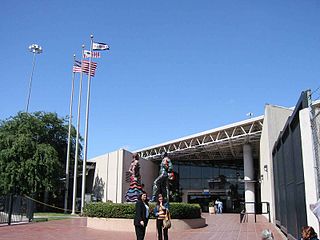
The Otay Mesa Port of Entry is one of three ports of entry (POE) in the San Diego–Tijuana metropolitan region, in the U.S. state of California, connecting Otay Mesa in the City of San Diego with the Otay Centenario borough of Tijuana. The facility was opened in 1983, and was constructed primarily to divert growing commercial truck traffic from the busy San Ysidro Port of Entry, located 5.2 miles (8.4 km) west. Since then, significant passenger vehicle and pedestrian traffic has grown as development in the area around the crossing has grown. Commercial importations through Otay Mesa accounts for billions of dollars' worth of freight.

The El Paso Stanton Street Port of Entry, located at the Good Neighbor International Bridge is limited to processing passenger vehicles that are enrolled in the SENTRI program. It is open from 6:00 AM - midnight weekdays, and 8:00 AM - midnight Saturdays and Sundays.

The El Paso Paso del Norte (PDN) Port of Entry is a crossing of the United States–Mexico border, connecting the U.S. city of El Paso, Texas with the Mexican city of Ciudad Juárez, Chihuahua. It is among the busiest border crossings between the two countries: more than 10 million people enter the U.S. from Mexico each year at this location. The PDN Port of Entry is located at the Paso del Norte International Bridge, and is limited to northbound non-commercial traffic, although pedestrians may also cross the bridge in the southbound direction.
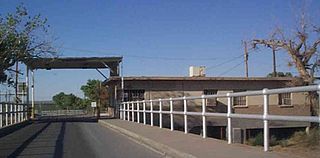
The Fabens Port of Entry was a port of entry at the Mexico–United States border, in the town of Fabens, Texas. It closed on November 17, 2014, and traffic was diverted to the nearby Tornillo Port of Entry. This facility was located at the Fabens–Caseta International Bridge, after that two-lane bridge was built by the International Boundary and Water Commission in 1938.
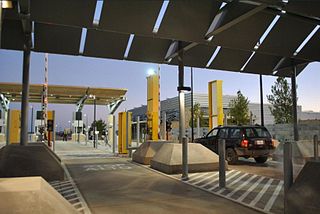
The Marcelino Serna Port of Entry is a crossing of the United States–Mexico border. It opened on November 17, 2014, replacing the nearby Fabens Port of Entry. The crossing is built around the Tornillo–Guadalupe International Bridge about 1,800 feet (550 m) west of the previous two-lane Fabens–Caseta International Bridge and can accommodate vehicular, pedestrian, and commercial traffic. The U.S. Customs and Border Protection (CBP) facility at the crossing served as the site for the Tornillo tent city, which housed as many as 2,800 detained migrant youths from June 2018 to January 2019. As of July 2019, a 2,500-bed holding facility for adult migrants is under construction at the site.

